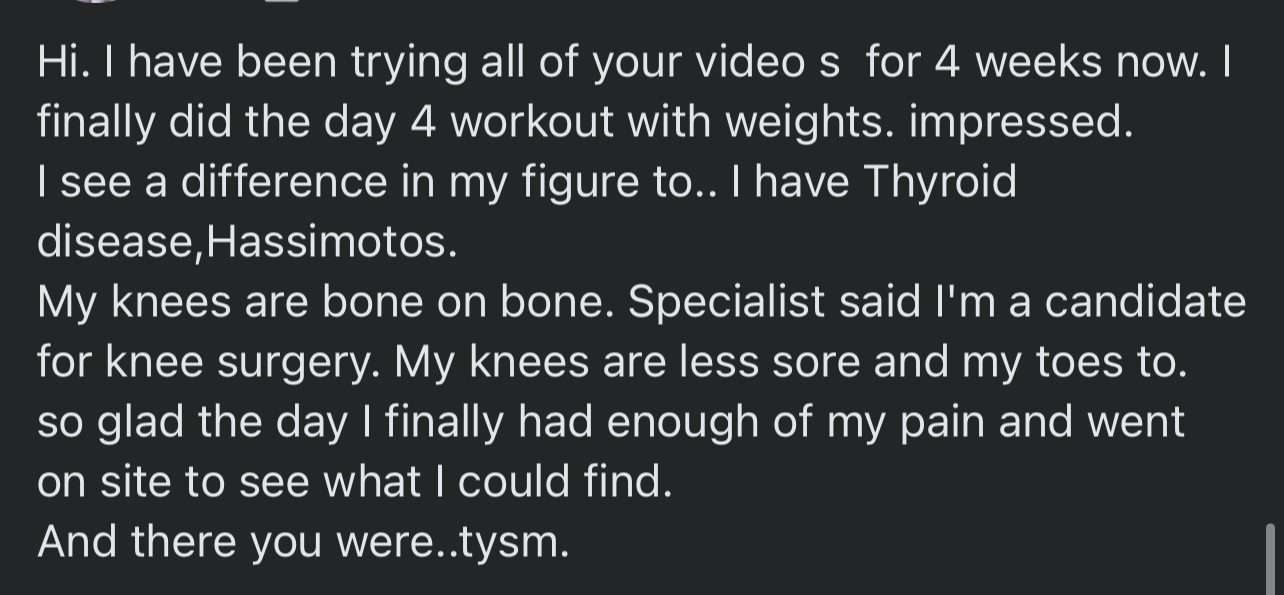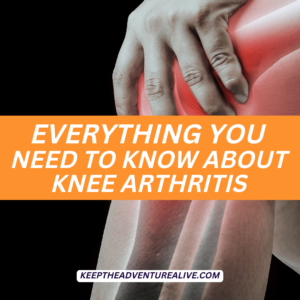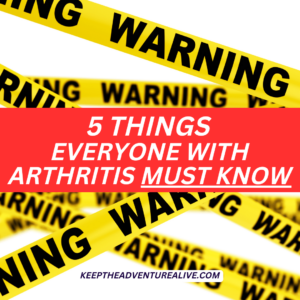Are you feeling scared or overwhelmed with bone on bone knee pain? If you are, I’m glad you’re here! I want you to know that you are not alone in this. There is hope in finding pain relief. There is hope in leading an active life. You do have options besides surgery in this scenario. It is extremely important that you take the right action to avoid further complications and worsening pain. Learn the 11 things you should avoid if you are experiencing bone on bone in the knee.
This article may contain affiliate links which means you buy through links on our site, we may earn an affiliate commission without any extra cost to you.
There is hope if you have bone on bone knee pain
Contrary to popular belief, a diagnosis of “bone on bone” doesn’t automatically mean you will be in pain until you get a joint replacement. You may be led to believe there is nothing that can be done if cartilage is worn away…
But, that’s actually not true. There is something you can do to find relief.
What’s surprising is that some people are “bone on bone” but don’t end up experiencing any pain. Others have very severe pain. What is the difference between the two scenarios?
Well, pain comes when the tissues around and inside the joint get irritated. Irritation typically occurs when you have higher amounts of inflammation in your body.
Inflammation can interfere with cellular processes and joint repair. It can be quite complicated- here’s a research article with the detailed physiology if interested.
Inflammation is tied to the foods you eat, the movements you do or don’t do, genetic predisposition, extra weight you carry and other factors.
There is good news, though!
If you reduce the inflammation, you can dramatically reduce pain levels. You can do this in a variety of different ways, but these next 11 things are important things to avoid to increase chances of relief.
Here’s a sneak peek at what is possible even with bone on bone knee pain:



Table of Contents
1. Avoid sitting for longer than 20 minutes
When bones are irritated, they don’t love being in the same position for a long time. Movement helps to move inflammation out of the joint and bring blood flow to the area. This helps to lubricate the joint.
Staying in the same position for > 20 minutes can allow your knee joint to become very stiff as the inflammation settles. Your muscles likely remain relatively inactive when sitting so blood flow can also decrease to the joint too.
When you are in pain with bone on bone in the knee, you are much more susceptible to stiffness compared other mild cases. Read more on the osteoarthritis stages here.
Simple movement can help to significantly reduce stiffness accompanied also by decreased pain. Anything to keep your legs moving and in different positions can make a big difference! This video below can give you simple ideas to get started.
2. Avoid just focusing on the knee
With pain, many professionals tend to just look at the joint that hurts. Many times its possible that pain can be coming from other joints! This is why some knee surgeries and procedures don’t end up relieving pain in the long term.
Our bodies are connected so it’s important to consider that with treatment. Your hips, ankles, and/or spine can be contributing to your knee pain. But if you just get an x-ray of your knee, that likely isn’t telling you the whole picture.
Working out and strengthening your other joints is just as important as getting your knee stronger! This is even more important when you have bone on bone knee pain. You need as much help from other muscles and joints as you can get.
Unsure of where to start? Learn the three secrets to finding arthritis pain relief and getting started on your Arthritis Adventure in this free webinar here!
3. Avoid inflammatory foods
Processed, unnatural foods are some of the most impactful to the levels of inflammation in your body. Food is extremely powerful when it comes to arthritic joint pain.
The more inflammation we have in our bodies, the more susceptible our bones are to getting irritated. Quite often though, when getting diagnosed with bone on bone in the knee, you may be given some information on exercise but information about inflammatory foods is much more rare.
Making simple changes to your diet can reduce pain levels. The kicker is, you have to be consistent in making healthier choices. That is why I typically recommend starting small because it is likely easier to maintain over the long run.
If you want to see my favorite list of anti-inflammatory foods recommended for arthritis sufferers, check it out here.
4. Avoid trying to do everything on your own
I know that asking for help can be hard but in some cases, it can be crucial to reduce bone on bone knee pain.
Essentially, the main goal is to decrease irritation. If you are constantly irritating your joint by standing too much, walking too much, carrying heavy objects, etc. you are likely continuing to fuel the irritation. This delays pain relief.
Don’t get me wrong, activity can be very beneficial when dealing with arthritis. Overactivity is what you need to avoid.
Having someone help with daily tasks and errands that tend to flare up your pain is definitely something to consider when you have higher levels of pain.
Remember, this doesn’t have to be permanent. If you are able to successfully reduce some of the inflammation, you will likely be able to return to these tasks! Don’t be afraid to ask for help.
5. Avoid ruling out a cane or another walking device
If your bone on bone knee pain is severe enough or if your knee tends to give way frequently, you likely will limp when you walk.
Oftentimes, people try to put off using a cane for as long as possible. The longer you limp, the more irritation you create. You may also be putting other joints at risk for pain because of the uneven forces you put through your joints.
When you walk, you want to be as symmetrical as possible- that’s what your joints like.
If you are unable to walk without a limp, a cane or a walker if you are feeling unsteady, can be extremely helpful while you get stronger.
Walking devices can be temporary. I recently was working with a woman who had been using a cane for a few years because of knee arthritis. After a few weeks, she was able to get rid of it completely! She put in the work to become stronger and more confident so she no longer needed the support. Using it in the beginning did help to decrease joint irritation though. So don’t rule out these devices just yet!
6. Avoid overdoing it
Physical activity is great for arthritis but as you know, too much of a good thing can be detrimental. This is especially true when experiencing bone on bone knee pain.
The best way to avoid overdoing it is to listen to your body and be aware of what your joint can tolerate.
If you experience pain after walking a certain distance, after a certain exercise, or after being on your feet for a certain period of time- take note of what that time or distance is. This can help you plan rest breaks and modify activities as you need to.
Unfortunately, you may have to learn this the hard way. But once you do, the information can be valuable by preventing future pain flares. The video below describes what to look for to determine if you’ve overdone it.
7. Avoid relying on passive treatments
Passive treatments include most services or products that are done to you. Examples can include massage, acupuncture, chiropractic care, medications, and injections.
Now, I am by no means saying these won’t help or you shouldn’t do them. But, trouble can come when we solely rely on these for our only source of pain relief.
It is important to find an active approach as well. Medications, pain relief gels and lotions, braces, and massage can be a great supplement to an exercise program and appropriate diet. Using both together can help to maximize your results.
With bone on bone in the knee, it’s SO important to find ways you can use food and movement to find relief too. If you don’t, you could spend the rest of your life counting down the days until your next massage or injection. We don’t want that when there are other options!
8. Avoid putting a pillow underneath your knee
With knee arthritis, you may experience tightness in the front or the back of the knee. You may also begin to experience a loss of range of motion, usually the inability to fully straighten it.
In order to regain extension or prevent losing further range of motion you have to spend some time with your knee straight.
Placing a pillow behind the knee when resting can contribute to decreased ability to straighten your leg, especially when sitting for long periods of time.
Maintaining or regaining the ability to straighten your knee is very important as it can dramatically affect your walking. Trying to work to get your knee straight and avoiding keeping it in a semi-bent position can help you to keep your range of motion!
If you need ideas on how to get your knee straight, check out this video.
9. Avoid getting less than 7-8 hours of sleep
According to a study on the impact sleep has on pain, it was found that
“...experimental and clinical data indicate that sleep deprivation lowers the pain threshold, lowers the cognitive ability to cope with pain, and increases ratings of pain intensity, which in turn exacerbates poor sleep"
Turk et al. 2016
Sleep is critical for our bodies to repair and recover, even more so with arthritis. With less than 7 hours of sleep, there are many potential consequences including,
- increased irritability
- decreased motivation for exercise
- higher susceptibility to eat unhealthy foods
- higher levels of pain
…and many others.
I understand, sleep can be difficult when dealing with bone on bone knee pain. I would recommend trying to sleep with a pillow between your legs to keep your joints in a better position.
I was working with a woman who was having a burning sensation on the inside of her left knee that would wake her up at night, sometimes up to 2-3 times. After going through our one on one program that involved different exercises and diet changes, her pain at night had disappeared!
I want you to know that if you do have pain at night, there is hope that you can sleep peacefully again! Check out this video below for more tips on better sleep.
10. Avoid unsupportive shoes
Shoes can make a big difference when it comes to bone one bone knee pain. The idea of supportive shoes is that when you are walking they absorb some of the force instead of transmitting all of it to your joints.
If your joints are already irritated and painful, more stress is not what we want.
One of my favorite brands I recommend to all of my clients and even wear myself are called Kuru Footwear. They are specifically designed for those with arthritis, plantar fasciitis and other pains. I have a pair of the Chicane and the Atom that make my feet feel amazing.
Shoes are usually recommended to be replaced every year (maybe two if you don’t have too many miles on them!). Older shoes tend to lack support and structure they once had. If you’ve had a pair that you still wear for more than 1-2 years, it’s time to head to Kuru and get yourself a pair!
11. Avoid giving up
I want you to know that there is hope. You can do this.
It is possible to relieve your bone on bone knee pain and live a life that you love. Once you are able to find the best ways to decrease irritation, there are so many possibilities.
You do have options when it comes to finding relief. Many think that bone on bone is a one way ticket to surgery but that actually doesn’t have to be the case. Finding ways to decrease inflammation and avoiding these 10 things can get you on the right path!
Don’t give up. You deserve a life that you love.
If you would like to get started today, Adventurers for Life is ready to guide you on your journey to pain relief.
This signature membership provides a step by step path to make activities like standing, walking, building strength, kneeling and stair climbing as well as higher intensity exercise possible again. You’ll learn how to strengthen and keep your joints healthy while you regain your active life.
Tackling bone on bone knee pain
These 11 things can help you begin to take steps towards reducing bone on bone knee pain and realizing adventure is possible.
Of course, there is a time and a place for surgery as these methods above may not work perfectly for everyone (as much as I wish they would!) I have an article on how to decide on a joint replacement here.
The most important part of getting started and seeing results is being consistent. You have to be consistent with the right steps in order to reap the benefits.
Typically, people may begin to see results after consistent efforts for about 4-6 weeks. Think about it, if your efforts could help you to avoid surgery and go on that trip you’ve always wanted to, how hard would you work for that?
If you have a trip coming up, check out this post on How to Actually Enjoy Traveling with a Bone on Bone Knee.
Now, it’s time to become an Adventurer for Life to make your dreams possible again.
Alyssa Kuhn
Disclaimer: This post is for general informational purposes only. It should not be used to self-diagnose and it is not a substitute for a medical exam, cure, treatment, diagnosis, and prescription or recommendation. It does not create a doctor-patient relationship between Dr. Kuhn and you. You should not make any change in your health regimen or diet before first consulting a physician and obtaining a medical exam, diagnosis, and recommendation. Move Well Age Well, LLC and Dr. Alyssa Kuhn, PT, DPT are not liable or responsible for any advice, course of treatment, diagnosis or any conclusions drawn, services or product you obtain through this video or site.




